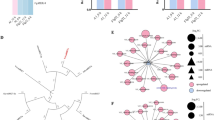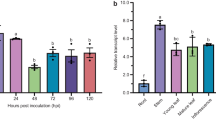Abstract
Activation of two mitogen-activated protein kinases (MAPKs), wound-induced protein kinase (WIPK) and salicylic acid-induced protein kinase (SIPK), is one of the earliest responses that occur in tobacco plants that have been wounded, treated with pathogen-derived elicitors or challenged with avirulent pathogens. We isolated cDNAs for these MAPKs ( NbWIPK and NbSIPK) from Nicotiana benthamiana. The function of NbWIPK and NbSIPK in mediating the hypersensitive response (HR) triggered by infiltration with INF1 protein (the major elicitin secreted by Phytophthora infestans), and the defense response to an incompatible bacterial pathogen ( Pseudomonas cichorii), was investigated by employing virus-induced gene silencing (VIGS) to inhibit expression of the WIPK and SIPK genes in N. benthamiana. Silencing of WIPK or SIPK, or both genes simultaneously, resulted in reduced resistance to P. cichorii, but no change was observed in the timing or extent of HR development after treatment with INF1.







Similar content being viewed by others
References
Baulcombe DC (1999) Fast forward genetics based on virus-induced gene silencing. Curr Opin Plant Biol 2:109–113
Baulcombe DC, Chapman S, Santa Cruz S (1995) Jellyfish green fluorescent protein as a reporter for virus infections. Plant J 7:1045–1053
Bradford MM (1976) A rapid and sensitive method for the quantitation of microgram quantities of protein utilizing the principle of protein-dye binding. J Biochem 72:248–254
Burton RA, Bibeaut DM, Bacic A, Findlay K, Roberts K, Hamilton A, Baulcombe DC, Fincher GB (2000) Virus-induced silencing of a plant cellulose synthase gene. Plant Cell 12:691–705
Davis R (2000) Signal transduction by the JNK group of MAP kinases. Cell 103:239-252
Droillard MJ, Thibivilliers S, Cazalé AC, Barbier-Brygoo H, Lauriére C (2000) Protein kinases induced by osmotic stresses and elicitor molecules in tobacco cell suspensions: two cross-road MAP kinases and one osmoregulation-specific protein kinase. FEBS Lett 474:217–222
Hikichi Y, Suzuki K, Toyoda K, Horikoshi M, Hirooka T, Okuno T (1998) Successive observation of growth and movement of genetically lux -marked Pseudomonas cichorii and the response of host tissues in the same lettuce leaf. Ann Phytopathol Soc Jpn 64:519–525
Kamoun S, Young M, Glascock C, Tyler BM (1993) Extracellular protein elicitors from Phytophthora: host-specificity and induction of resistance to fungal and bacterial phytopathogens. Mol Plant-Microbe Interact 6:15–25
Kamoun S, Young M, Forster H, Coffey MD, Tyler BM (1994) Potential role of elicitins in the interaction between Pytophthora species and tobacco. Appl Environ Microbiol 60:1593–1598
Kamoun S, van West P, de Jong AJ, de Groot KE, Vleeshouwers VGAA, Govers F (1997) A gene encoding a protein elicitor of Phytophthora infestans. Mol Plant-Microbe Interact 10:13–20
Kamoun S, van West P, Vleeshouwers VGAA, de Groot KE, Govers F (1998) Resistance of Nicotiana benthamiana to Phytophthora infestans is mediated by the recognition of the elicitor protein INF1. Plant Cell 10:1413–1425
Keller H, Blein JP, Bonnet P, Ricci P (1996) Physiological and molecular characteristics of elicitin-induced systemic acquired resistance in tobacco. Plant Physiol 110:365–376
Lee J, Klessig DF, Nürnberger T (2001) A harpin binding site in tobacco plasma membranes mediates activation of the pathogenesis-related gene HIN1 independent of extracellular calcium but dependent on mitogen-activated protein kinase activity. Plant Cell 13:1079–1093
Matsumura H, Nirasawa S, Kiba A, Urasaki N, Saitoh H, Ito M, Kawai-Yamada M, Uchimiya H, Terauchi R (2003) Overexpression of Bax inhibitor suppresses fungal elicitor-induced cell death in rice ( Oryza sativa L.) cells. Plant J 33:425–434
Mikolajczyk M, Awotunde OS, Muszynska G, Klessig DF, Dobrowolska G (2000) Osmotic stress induces rapid activation of a salicylic acid-induced protein kinase and a homolog of protein kinase ASK1 in tobacco cells. Plant Cell 12:165–178
Peart JR, Cook G, Feys BJ, Parker JE, Baulcombe DC (2002a) An EDS1 orthologue is required for N -mediated resistance against tobacco mosaic virus. Plant J 29:569–579
Peart JR, Lu R, Sadanandom A, Malcuit I, Moffett P, Brice DC, Schauser L, Jaggard DAW, Xiao S, Coleman M, Dow M, Jones JDG, Shirasu K, Baulcombe DC (2002b) Ubiquitin ligase-associated protein SGT1 is required for host and nonhost disease resistance in plants. Proc Natl Acad Sci USA 99:10865–10869
Pernollet JC, Sallantin M, Salle-Tourne M, Huet JC (1993) Elicitin isoforms from seven Phytophthora species: comparison of their physico-chemical properties and toxicity to tobacco and other plant species. Physiol Mol Plant Pathol 42:53–67
Qutob D, Kamoun S, Gijzen M (2002) Expression of a Phytophthora sojae necrosis-inducing protein occurs during transition from biotrophy to necrotrophy. Plant J 32:361–373
Romeis T (2001) Protein kinases in the plant defence response. Curr Opin Plant Biol 4:407–414
Romeis T, Piedras P, Zhang S, Klessig DF, Hirt H, Jones JDG (1999) Rapid Avr9- and Cf9-dependent activation of MAP kinases in tobacco cell cultures and leaves: convergence of resistance gene, elicitor, wound, and salicylate responses. Plant Cell 11:273–287
Romeis T, Piedras P, Jones JDG (2000) Resistance gene-dependent activation of a calcium-dependent protein kinase in the plant defense response. Plant Cell 12:803–815
Romeis T, Ludwig AA, Martin R, Jones JDG (2001) Calcium-dependent protein kinases play an essential role in a plant defence response. EMBO J 20:5556–5567
Saitoh H, Terauchi R (2002) Virus-induced silencing of FtsH gene in Nicotiana benthamiana causes a striking bleached leaf phenotype. Genes Genet Syst 77:335–340
Saitoh H, Kiba A, Nishihara M, Yamamura S, Suzuki K, Terauchi R (2001) Production of antimicrobial defensin in Nicotiana benthamiana with a potato virus X vector. Mol Plant-Microbe Interact 14:111–115
Samuel MA, Ellis BE (2002) Double jeopardy: both overexpression and suppression of a redox-activated plant mitogen-activated protein kinase render tobacco plants ozone sensitive. Plant Cell 14:2059–2069
Samuel MA, Miles GP, Ellis BE (2000) Ozone treatment rapidly activates MAP kinase signalling in plants. Plant J 22:367–376
Seo S, Okamoto M, Seto H, Ishizuka K, Sano H, Ohashi Y (1995) Tobacco MAP kinase: a possible mediator in wound signal transduction pathways. Science 270:1988–1992
Seo S, Sano H, Ohashi Y (1999) Jasmonate-based wound signal transduction requires activation of WIPK, a tobacco mitogen-activated protein kinase. Plant Cell 11:289–298
Voinnet O (2001) RNA silencing as a plant immune system against viruses. Trends Genet 17:449–459
Widman C, Gibson S, Jarpe MB, Johnson GL (1999) Mitogen-activated protein kinase: conservation of a three-kinase module from yeast to human. Physiol Rev 79:143–180
Xing T, Quellet T, Miki BL (2002) Towards genomic and proteomic studies of protein phosphorylation in plant-pathogen interactions. Trends Plant Sci 7:224–230
Yang K-Y, Liu Y, Zhang S (2001) Activation of a mitogen-activated protein kinase pathway is involved in disease resistance in tobacco. Proc Natl Acad Sci USA 98:741–746
Zhang S, Klessig DF (1997) Salicylic acid activates a 48 kD MAP kinase in tobacco. Plant Cell 9:809–824
Zhang S, Klessig DF (1998) Resistance gene N-mediated de novo synthesis and activation of a tobacco mitogen-activated protein kinase by tobacco mosaic virus infection. Proc Natl Acad Sci USA 95:7433–7438
Zhang S, Klessig DF (2001) MAPK cascades in plant defense signaling. Trends Plant Sci 6:520–527
Zhang S, Liu Y (2001) Activation of salicylic acid-induced protein kinase, a mitogen-activated protein kinase, induces multiple defense responses in tobacco. Plant Cell 13:1877–1889
Zhang S, Du H, Klessig DF (1998) Activation of the tobacco SIP kinase by both a cell wall-derived carbohydrate elicitor and purified proteinaceous elicitins from Phytophthora spp. Plant Cell 10:435–449
Zhang S, Liu Y, Klessig DF (2000) Multiple levels of tobacco WIPK activation during the induction of cell death by fungal elicitins. Plant J 23:339–347
Acknowledgements
We thank Dr. D. C. Baulcombe (Sainsbury Laboratory, John Innes Centre) for the gift of plasmids pPC2S and pTXS.GFP. We are grateful to Dr. S. Seo, Dr. Y. Ohashi (National Institute of Agrobiological Resources) for the provision of anti-WIPK antibody and for invaluable suggestions. We thank Dr. T. Romeis (Max-Planck-Institute for Plant Breeding Research), Dr. H. Yoshioka (Graduate School of Bioagricultural Sciences, Nagoya University) and Dr. Y. Hikichi (Faculty of Agriculture, Kochi University) for invaluable suggestions. PSC is thanks the JSPS for financial help in the form of an Invitation Research Fellowship. This work was carried out in a containment facility of Iwate Biotechnology Research Center under License No. 13-YokoShoku-965 from the Ministry of Agriculture, Forestry and Fisheries, Japan, and License No. 12-Ken-Kyoku-52 from the Ministry of Education, Culture and Science, Japan. This study was in part supported by the Research for the Future program of the Japan Society for the Promotion of Science
Author information
Authors and Affiliations
Corresponding author
Additional information
Communicated by R. G. Herrmann
Rights and permissions
About this article
Cite this article
Sharma, P.C., Ito, A., Shimizu, T. et al. Virus-induced silencing of WIPK and SIPK genes reduces resistance to a bacterial pathogen, but has no effect on the INF1-induced hypersensitive response (HR) in Nicotiana benthamiana . Mol Gen Genomics 269, 583–591 (2003). https://doi.org/10.1007/s00438-003-0872-9
Received:
Accepted:
Published:
Issue Date:
DOI: https://doi.org/10.1007/s00438-003-0872-9




